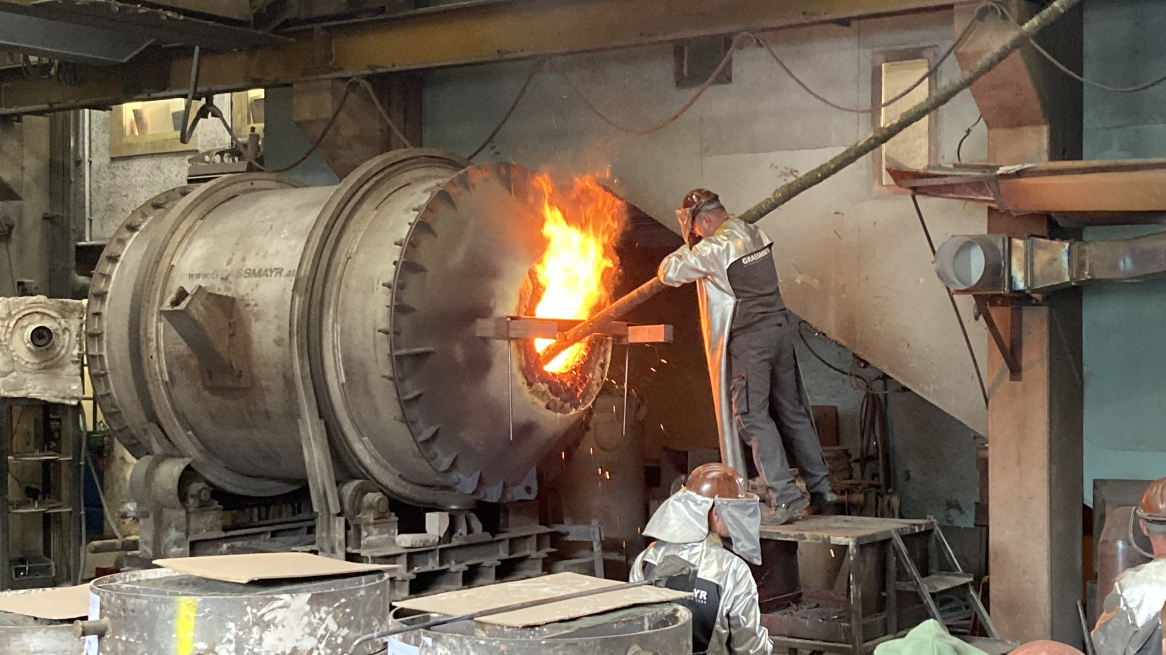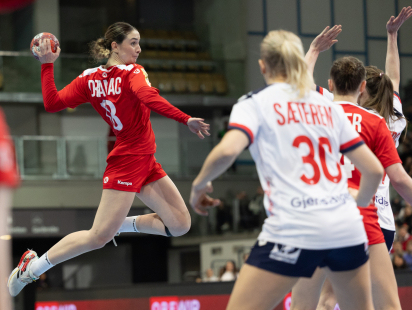
It is always a special event when the Grassmayr bell foundry invites you to be present live at a bell casting. On April 14, 2023, it was that time again. Ten new church bells were to be cast on this day. The rush was accordingly large. In addition to representatives from the places for which the bells were intended - Prague (Czech Republic), Dancu (Romania), Waldshut (Germany) and Wölfnitz an der Saualpe (Carinthia) - there were also interested people from Innsbruck and the surrounding area.
Austria Guide Monika Unterholzner shows how bells sound differently depending on the composition of the metal.
Oldest family business
"Bell foundry since 1599" is inscribed on the pale yellow, squat building on Innsbruck's Südring, Innsbruck's busy thoroughfare. The company has its roots in the hamlet of Habichen in the Ötztal, where Bartlmä Grassmayr cast his first bell in 1599. in 1836, the company moved to the former Ansitz „Straßfried“ in Innsbruck.
Since then, the traditional company has been located at this site. So it is no wonder that the crossing is called "Grassmayr crossing". With Johannes and Peter Grassmayr, the 14th generation now runs the bell foundry. This makes it the oldest family business in Austria.
When a bell is cast, the whole family is naturally involved in the operation - including Elisabeth and Christof Grassmayr, who has transferred the management of the company to his sons.
Complex procedure
Weeks of preparatory work prepare the molds for casting - view of the museum presentation of the Grassmayr bell foundry.
Before going to the foundry, Austria Guide Monika Unterholzner leads through the museum and explains the process. The production of a large bell requires months of technical and practical preparation. What used to be drawn and calculated by hand is now done by a computer program - but the actual casting works just as it used to. It takes immense know-how, strength, skill and precision (more exciting details here).
First, a core is bricked and coated with clay. On top of this comes a layer of grease as a separating agent. This core is recently covered with a clay mantle. A template precisely matched to the later bell shape ensures an even application all around.
In God's name
On the second layer of wax come the wax patterns for decorations and inscriptions, which were made by sculptors in an elaborate process. This is followed by another coating with a mass of clay, hay and horse apples. To stabilize the object, it is encased in a steel jacket. Then the whole thing hardens over several weeks.
Now the three parts can be separated. The false bell is removed, the wax ornaments are melted out with fire, and then the core and mantle are put together - the cavity for the bell is now found between them. The casting holes above the crown, the holder of the bell, remain free.
Attunement to the great event with the song "Before the bell casting".
With "In God's name" the priest blesses the bells. Peter Grassmayr (in the protective suit) crosses himself, behind on the right father Christof Grassmayr.
Since time immemorial, a bell has produced the perfect sound with an alloy of 80 to 20: 80 percent copper, 20 percent tin - heated to 1,100 degrees for casting! More than ten tons of metal were pre-melted for the current one. A total of three tons burned up in the process, adds Monika Unterholzner, before entering the foundry.
On the floor, ten bells in a metal corset, behind them the large drum with the molten metal. Workers in protective suits climb around between the molds, making final preparations. Of course, the divine blessing must not be missing. The priest consecrates the ten bells, spectators sing the song "Before the bells are cast," and with a "In God's name" the ceremony begins.
With power and precision
It's getting serious - the red-hot crowd is tapped.
An employee fills the mold, which is held together by solid metal clamps.
Christof Grassmayr moderates and asks those present to remain quiet during the casting process - Peter Grassmayr's team must be able to hear instructions. As has been done for hundreds of years, the hot metal is stirred once again with a damp alder log. It hisses and gurgles, smoke rises. And you can see how much strength it takes for the employee to move the log.
Then the glowing red bronze is pierced and flows into the first casting hole. Highly concentrated, the employees ensure a steady flow rate, making sure that the heat remains constant. Every step is precisely planned. They know that every mistake will be avenged. The pressure and tension are correspondingly high.
The casting itself takes only a few minutes, depending on the size of the bell. Then suddenly all eyes focus on one bell, murmuring can be heard. The "worst case" has occurred, says an audibly moved Peter Grassmayr. Bronze is leaking from a bell. "It's no use. We have to continue," he explains. It's like a ball in the water that you have to push down, he says. Here, he says, it didn't succeed. Somewhere the mold had lifted. Where and how and why will be clarified later.
The tension of the employees is now even higher, transferred to the spectators. But the team has to continue calmly and level-headedly, giving each bell the attention it needs. The casting of the nine other bells works. Breathe a sigh of relief. Just to mention in passing that among the spectators there is also Tobias Moretti was among the spectators - like everyone else, fascinated by what was happening.
According to the occasion, there are homemade cookies from Elisabeth Grassmayr to go with the schnapps.
Schnapps and pastries
For this day it is over. After a "Great God we praise you" there is a schnapps for everyone and pastries that Elisabeth Grassmayr has baked especially for the occasion. Since her marriage, this has also been part of the ritual after bell casting, this exciting "moment" for every bell caster since time immemorial.
The bell casters will experience the next emotional moment without spectators. After cooling down, they uncover the bell and clean it. The bell is made to vibrate and thus to ring. Only then will the Grassmayr family and their team know whether the casting has really succeeded.
Bell Foundry Grassmayr
Leopoldstraße 53
A-6020 Innsbruck
+43 512 / 59 41 637
museum@grassmayr.at
www.grassmayr.at
Photos, unless otherwise stated: © Susanne Gurschler
Rate this article
Show me the location on the map
Innsbruck has captured her heart, and the view of the Nordkette mountains soothes her soul. A journalist, non-fiction author, bookworm, amateur photographer, dog owner and mountain walker #ghostsofinnsbruck
Similar articles
The Axamer Lizum hosted the International German Ski Championships for the first time at the end of…
All waltz or what was that? My first dance steps were almost exactly 20 years ago. But…
Austria is about to experience a premiere as a sporting nation: together with Switzerland and Hungary, it…
The carnival in Axams is one of the six major traditions of the "fifth season" in Tyrol.Every…













